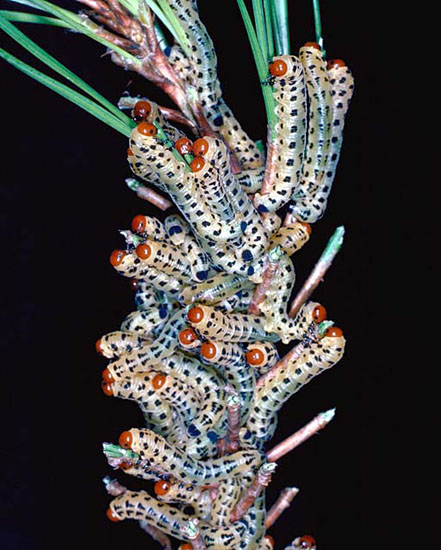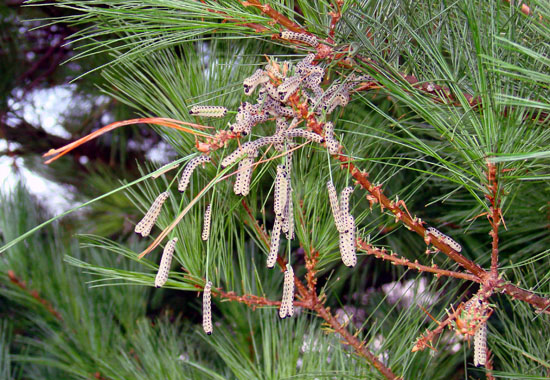Issue 9, June 30, 2014
Conifer Sawflies
The most common sawfly that attacks needled evergreens in Illinois is the European pine sawfly, which is present as damaging larvae in the spring. Because this sawfly finishes larval feeding at candle emergence, only second- and third-year needles are consumed. The result is that the emerging needles keep attacked branches alive, even though lower areas of the branch may be stripped of needles.
Less common in Illinois, but more devastating in high numbers, are the later-appearing redheaded pine sawfly and white pine sawfly. The larvae of these insects are present from summer into fall, with high populations eating all the needles off branches or entire trees, resulting in the death of branches and trees.
Adult sawflies are broad-bodied, with a thick abdomen, and have membranous wings. Females are larger and more robust than males. Sawfly females have a saw-like ovipositor, which they use to create slits or cuts in plant tissue. Eggs are then inserted into these slits, generally located on the edge of needles. A female can lay up to 100 eggs during her lifetime.
Redheaded pine sawfly, Neodiprion lecontei, feeds primarily on two- and three-needle pines and is particularly common on Scotch, jack, and red pines. They can also feed on five-needle pines, Norway spruce, and larch growing near two- or three-needle pines. The larva is about an inch long when fully grown, has a red head, and is yellow, with several rows of black dots. As with all sawfly larvae, it has more prolegs than caterpillars do (caterpillars have five or fewer pairs of prolegs). This species has seven pairs of prolegs on its abdomen, as well as three pairs of true legs on the front end of its body.

Redheaded pine sawfly larvae.
White pine sawfly, Neodiprion pinetum, feeds mainly on white pine; it also attacks red, Mugo, and other short-needled pines. White pine sawfly feeds from July through September and if left unchecked can cause severe damage to pines. The larvae are yellow- to cream-colored and have a deep black head. Four longitudinal rows of black spots run the length of the body, and a posterior black spot is at the end of the abdomen.

White pine sawfly larvae and damage.
Full-grown larvae of both species drop to the ground, where they pupate in silk cocoons. In southern Illinois, a second generation of redheaded sawfly larvae occurs in late August through September. In central and northern Illinois, only one generation per year of redheaded pine sawfly occurs. White pine sawfly occurs only in northern Illinois, where there is one generation per year. Winter is spent as a prepupa in a cocoon on or in the duff under trees. Thus, removing fallen needles and debris beneath infested trees in the winter should eliminate many of the mature larvae. The prepupae pupate in the spring, to emerge as adults a few weeks later.
White pine sawfly can be managed with pest-control materials such as acephate (Orthene), azadirachtin (Azatin/Ornazin), carbaryl (Sevin), chlorpyrifos (Dursban), and spinosad (Conserve). Spray applications should be made when larvae are small and feeding on needles. The microbial insecticide, Bacillus thuringiensis var. kurstaki (Dipel, Thuricide, and Javelin), that is used for controlling caterpillars, does not work on sawflies because sawflies are closely related to wasps and ants. Btk is effective against only the larvae of moths and butterflies. (Phil Nixon)
Author:
Phil Nixon